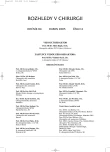Surgical Therapy of Iatrogenic Injury of Biliary Tract after Cholecystectomy and Invasive Endoscopy. Part 2.
Authors:
J. Šváb; M. Pešková; Z. Krška; R. Gürlich; M. Kasalický
Authors‘ workplace:
I. chirurgická klinika 1. LF UK a VFN v Praze, přednosta doc. MUDr. J. Šváb, CSc.
Published in:
Rozhl. Chir., 2005, roč. 84, č. 4, s. 182-190.
Category:
Monothematic special - Original
Overview
Introduction:
Introduction of endoscopic invasive procedures in the 70th and 80th years leaded to decrease reoperations on biliary tree. Iatrogenic injury of the biliary tract have increased in incidence in the first decade with the introduction of laparoscopic cholecystectomy. Athough a number of factors have been identified with a high risk of injury (and number of technical steps have been emphasized to avoid these injury, the incidence of the bile duct injury has reached at least double the rate observed with open cholecystectomy. Most patients that sustained a bile duct injury are recognized in the weeks following laparoscopic cholecystectomy. Careful preoperative preparation should include control of sepsis by draining any bile collections or fistulas and complete cholangiography. Long term results are best achieved in specialized hepatobiliary centers performing biliary reconstruction with a Roux-Y hepaticojejunostomy. Success rates over 90% have been reported from several centres to date with intermediate follow-up. Introduction of an invasive endoscopy. Very dangerous is injury after endoscopic papilotomy.
Own experiences:
In an article of a review of experiences of the Ist Department of Surgery of General hospital in Prague since 1971 in 1 017 reoperations on biliary tree has been carried out. There were in 311 patients 164 hepato-hepatostomies and 147 hepaticojejunostomies used (Tab. 1). By laparoscopic injuries in the last decade were hilary injuries (Bismuth IV) and hepaticojejunostomy was done in all cases. Died 6%, long term results are acceptable by injured patients with hepatico hepaticostomies in 70%, by hepaticojejunostomies in 90%. Reoperated were 10% patients. Remnant patients were dilated endoscopically. Postoperatively morbidity was high, above 26%. In years 1995–2003 were 8 patients with papila injury and inflammation in retroperitoneum operated as a injured duodenum (Tab. 2).
Conclusions:
Better experiences with treatment of injured biliary tree and papila are in centres interested in hepatobiliary surgery which know anatomy of hilus of the liver and can see wide hepaticojejunostomy. Transfer of drained injured patient to centre is possible.
Key words:
biliary tree injury – bile duct injury – papila Vateri injury – bile duct stenosis
Labels
Surgery Orthopaedics Trauma surgeryArticle was published in
Perspectives in Surgery

2005 Issue 4
Most read in this issue
- Carcinoids of the Appendix
- Prevention, Diagnosis and Treatment of Iatrogennic Lesions of Biliary Tract during Laparoscopic Cholecystectomy. Managament of Papila Injury after Invasive Endoscopy. Part 1.
- Cooperation between a Surgeon and a Gastroenterologist in the Management of Vascular Complications of the Liver Cirrhosis
- Surgical Therapy of Iatrogenic Injury of Biliary Tract after Cholecystectomy and Invasive Endoscopy. Part 2.
